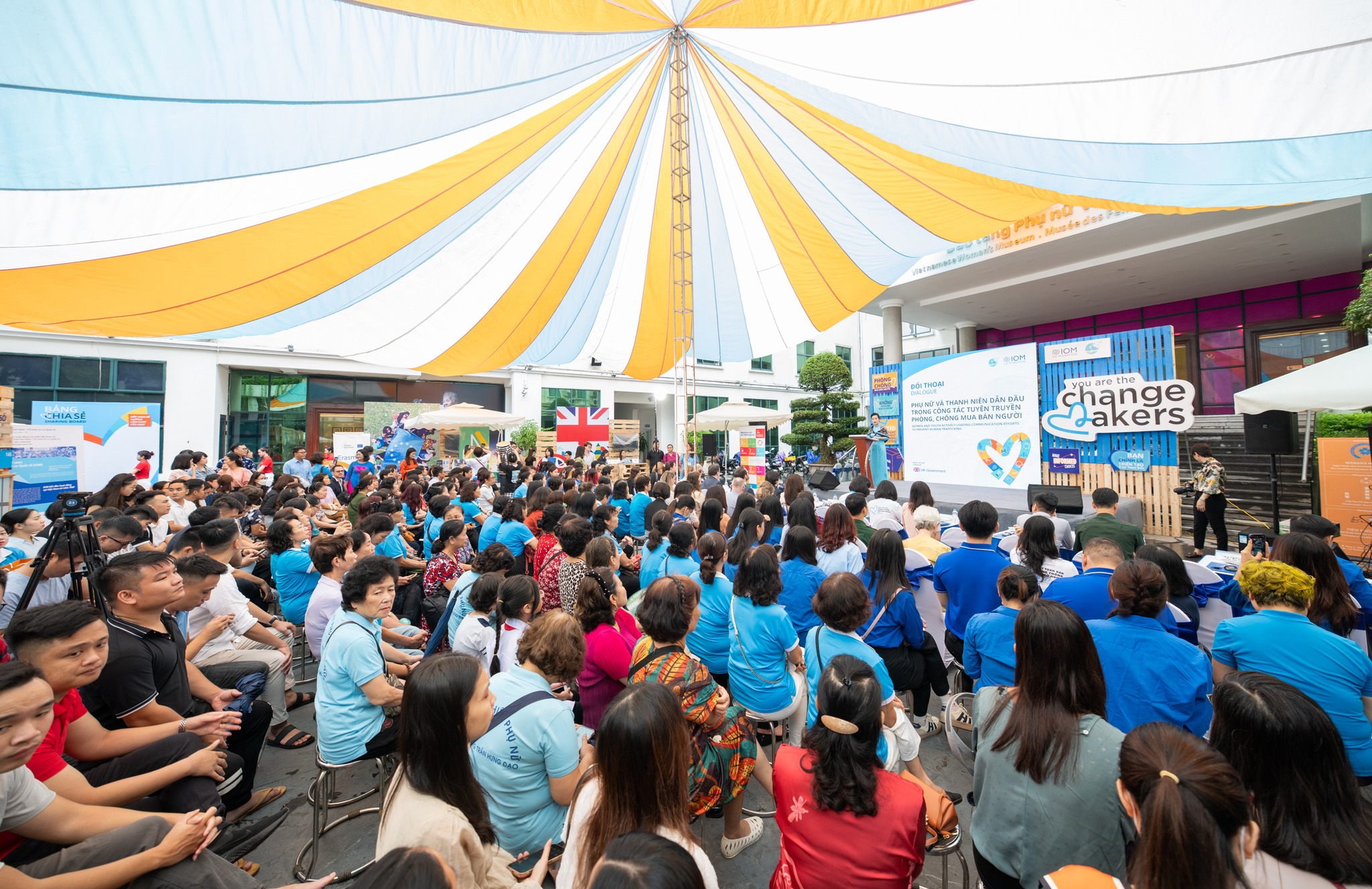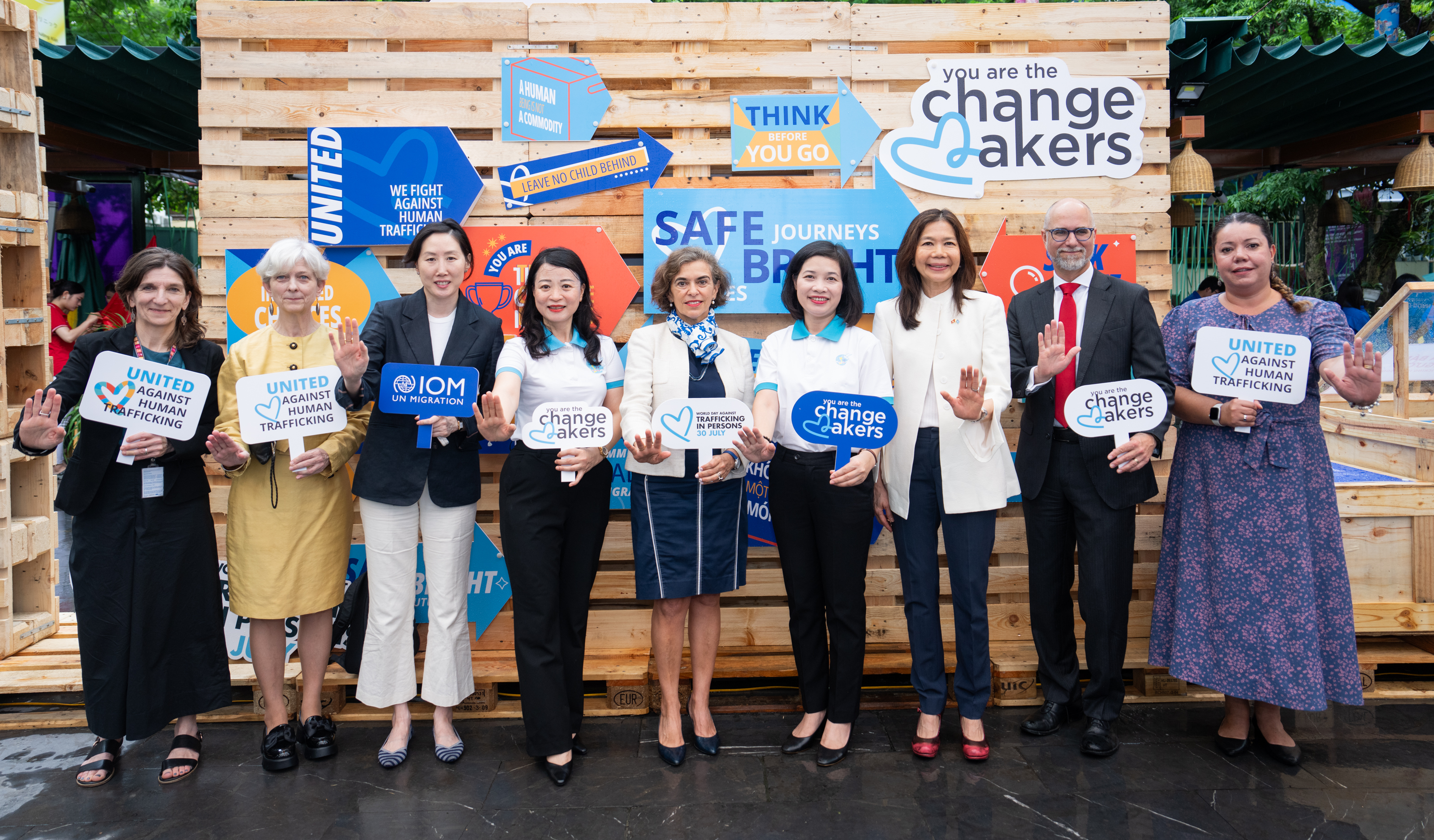-
Who We Are
WHO WE AREThe International Organization for Migration (IOM) is part of the United Nations System as the leading inter-governmental organization promoting since 1951 humane and orderly migration for the benefit of all, with 175 member states and a presence in over 100 countries. IOM has had a presence in Viet Nam since 1987.
About
About
IOM Global
IOM Global
-
Our Work
Our WorkAs the leading inter-governmental organization promoting since 1951 humane and orderly migration, IOM plays a key role to support the achievement of the 2030 Agenda through different areas of intervention that connect both humanitarian assistance and sustainable development. Across Viet Nam, IOM is concerned with the welfare and quality of life of the Vietnamese people, particularly migrant and mobile populations.
Cross-cutting (Global)
Cross-cutting (Global)
- Data and Resources
- Take Action
- 2030 Agenda
Youths are empowered to lead a national movement to combat human trafficking and drive for transformative change
HA NOI, 2 August, 2024 – More than 200 young students from several universities and colleges in Ha Noi and young changemakers, as part of IOM’s Youth-led initiatives for safe migration and human trafficking prevention programme, joined the “Dialogue with Leaders: Women and Youth actively leading communication efforts to prevent human trafficking” to exchange ideas with leaders from Government agencies, international organizations and private sector to call for comprehensive actions to empower youths to act to tackle human trafficking.

This is the first time such a dialogue has been organized by the Viet Nam Central Women Union and the International Organization for Migration (IOM), in partnership with the UK Government.
The dialogue is part of Viet Nam’s National Day Against Trafficking in Persons, which runs from 1 July to 30 September 2024. Together with other UN agencies in Viet Nam, IOM Viet Nam aims to underscore the importance of inclusive and focused efforts to protect children and young people, including addressing risk and vulnerability, enhancing resilience, and strengthening the protection of children in the context of trafficking in persons.

Globally, an average of one in three victims of human trafficking globally is a child – although in some regions, the proportion is much higher – and children are twice as likely as adults to face violence while being trafficked. IOM’s research pointed out that no age group, gender or nationality is immune from trafficking in persons. Family members or friends are involved in more than 50 per cent of cases. And ever-evolving online platforms are making it easier for traffickers to exploit children while avoiding detection.
According to IOM Chief of Mission Ms Park Mi-Hyung, Viet Nam’s steering efforts to effectively promote safe migration and human trafficking prevention, especially the nation’s effort to finalize the revised 2011 Law on Human Trafficking Prevention and Combat, are remarkable milestones for Viet Nam and show the nation’s commitment to tackle this crime. This law revision will establish a stronger foundation for addressing the increasingly complex trends in trafficking in persons, which are exacerbated by socio-economic challenges.

However, the IOM’s Chief of Mission also noted that today’s youth face a dual-edged reality in the fight against trafficking in persons. With nearly 2.4 billion youth in all over the world, this is the largest generation in history. Of the 281 million international migrants, approximately 11.3% were below 24 years of age. Meanwhile, in Viet Nam, there are over 22 million young people between the ages of 16 and 30, and many have considered moving out of their hometowns for better work and study opportunities.
As digital natives, the youth are increasingly vulnerable to traffickers who exploit online platforms to prey on young individuals. However, this same generation holds the power to drive significant changes. Their dynamism, creativity, and tech-savviness uniquely position them to develop innovative solutions to combat trafficking in the digital age. Therefore, investing in this generation empowers them to safeguard their peers and harnesses their potential to build a safer, more resilient world.
In the opening remark of the event, United Nations Resident Coordinator, Ms Pauline Tamesis, stated: “While we are working closely with each other to effectively tackle the challenges posed by human trafficking, we need to engage youth in crafting their key advocacy messages for human trafficking prevention campaigns. We need to act now to create an even more supportive environment for youth-led advocacy, driving social and behavioural change, and assist them to realize their full potential by delivering on the promise of migration.”

“Taking action against illegal migration and human trafficking continues to be a top priority for the UK Government. We are committed to working more closely with Viet Nam to combat human trafficking, particularly by boosting capacity building, raising awareness, information-sharing, prosecuting the criminals involved, and protecting vulnerable people. We hope to spread the message to raise people's awareness about the risks involved in illegal migration and careful consideration of their options when contemplating a migration path to protect themselves and the future welfare of their families,” British Ambassador to Viet Nam, H.E. Iain Frew stated.

The dialogue was also the venue of a side event, the “Changemakers United: Take action to end human trafficking” exhibition and interactive space, where children, young people and their parents could proactively learn to spot the signs of human trafficking and equip themselves with essential knowledge and skills to an informed decision and prevent human trafficking.
For media inquiries, please contact:
Ms Nguyen Ngoc Tram, National Communications Officer - ngocnguyen@iom.int/ Mob: 0912893964








Background information:
The theme for the World Day Against Trafficking in Persons (WDATIP) this year is “Leave No Child Behind in the Fight Against Human Trafficking”.
- Findings from IOM’s joint research with Harvard University (From Evidence to Action: Twenty years of IOM child trafficking data to inform policy and programming) show that no age range, no gender, and no nationality is immune to child trafficking; it is a truly global phenomenon. According to UNODC’s Global Trafficking in Persons Report, 1 in 3 victims of trafficking are children. Despite efforts, large numbers of children continue to fall victim to traffickers worldwide, due to inequitable social, economic, environmental and political factors that engender exploitative and discriminatory practices.
- Combatting trafficking in persons should remain an international priority, with responses tailored to the context of each country, and to the complex intersection of individual, community and societal factors affecting children.
